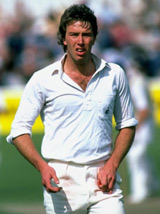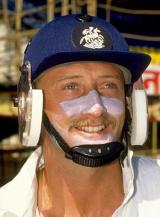Next Botham: the quest ends
Peter Hayter
|
|

|
For nearly a quarter of a century, anyone who batted a bit and bowled a bit for the England team has had a label stuck round his neck. The comparison was inevitable, and somehow it always sounded like a lament. English cricket harked back to Headingley '81 even though the current team, increasingly, had no memory of it whatever.
Finally, in 2005, the lament was over. Following his one-man show on the Saturday of the Edgbaston Test, Andrew Flintoff - who was three and a half in the summer of 1981 - was asked by Australian reporters what he felt about being called the next Ian Botham. "I don't see it like that," he said. "As far as I'm concerned I'm just having fun, playing cricket with my mates." Flintoff paid no heed to the past whatever. Now who does that remind you of?
Later that month, at Trent Bridge, Flintoff was able to raise his batting average above his bowling average for the first time, the statistical benchmark of the true allrounder. Then in September came the moment when Flintoff really infiltrated English hearts, and became the nation's Freddie. In Trafalgar Square, amid champagne, fireworks and tickertape, he was asked what he had eaten since the celebrations started the previous evening. "A cigar," he replied. "I've not been to bed," he explained to David Gower, Nelson's column and a crowd of thousands - even though he could barely tell which was which. "Behind these shades there's a thousand stories."
Vintage Botham. Sporting god as one of us. No wonder the bookmakers stopped taking bets on who would win the award for BBC Sports Personality of the Year because they concluded Flintoff was a certainty for a trophy not won by a cricketer since... 1981. But now that the comparison with Botham was legitimate, no one had to make it any more. Whole generations of allrounders had been blighted by being called The Next Botham the moment they put on an England cap. That problem is over.
To understand what those in between had to endure, it may be necessary to explain to the Flintoff generation exactly what Botham did. In 102 Tests, he scored 5,200 runs at an average of 33.54, taking 383 wickets (still far more than anyone else in England's Test history) at 28.40, and 120 catches, also still an England record. He also endured an up-and-down relationship with the tabloid press over his successes, his failures, his sins and his charitable saintliness that meant he constantly seemed on the brink of being worshipped or burnt at the stake.
When his powers faded, he left behind a giant-sized hole: as a No. 6 batsman who could score hundreds, a bowler capable of taking five wickets in an innings regularly, a fielder able to catch flies, and a rough-and-ready table-turner straight out of the comic books.
For long though, David Capel batted there in nine Tests, and Craig White, Derek Pringle and even Ronnie Irani all had a go. But a whole series of Next Bothams were used lower down the order. The collective records of allrounders between Botham and Flintoff who played ten Tests or more - Capel, Pringle, White, Phil DeFreitas, Chris Lewis, Dominic Cork and Alex Tudor - reads as follows: 198 matches, 5,253 runs at 18.49, 542 wickets at 34.79, and about a million comparisons with Botham, always over-optimistic when they were first chosen, and exasperated when inevitably they failed to live up to the billing.
The first was Pringle, picked for England as a Cambridge undergraduate when Botham was still close to his peak. He at least showed something of the brass neck which the young Botham had famously shown in his bar-room brawl with Ian Chappell.
|
|

|
"I didn't start off too well with Beefy," says Pringle. "The first time I came across him was in 1981. I was playing a late-season game for Essex at Taunton, and chatting to Nigel Popplewell about the political situation in South Africa. Ian was getting stuck in at the bar with John Lever and others he had been on England tours with, and he wandered over and gave us his two penn'orth. Callow student that I was, I said `I don't remember asking you,' and he sort-of looked at me as if to say `Who's this muppet?'
"Once we played in the England side together we got on famously. I do recall people proposing the idea that I should be compared to him as a cricketer, but I'm a realist, and to me the whole idea was preposterous. I knew he was an amazing player and that I would never be able to emulate him. He never mentioned it, either, which means he thought it was just as preposterous as I did."
Clearly, none of the contenders could bat like Botham. Indeed, only Lewis and White managed to average more than 20. White was capable of bowling reverse swing at 90mph-plus and able to apply himself to long innings, but was eventually undone by the physical demands of converting himself too late in life from off-spin to pace. Lewis looked to have everything: pace with the ball, superb athleticism and excellent batting technique. Yet the fire within him seemed too easily extinguished and sometimes impossible to light at all. The most successful bowlers were Cork and DeFreitas. Cork possessed useful outswing and what is known as "big match temperament". But he was dogged by knee problems and prone to the occasional loss of focus. DeFreitas felt acutely the problems of living up to the fact of Botham, and also the legend.
DeFreitas had arrived in Australia at the start of the 1986-87 Ashes tour as a 20-year-old with two seasons for Leicestershire under his belt, there to look and learn. He had talent, potential and, when he enjoyed enough early success to be picked for the Test side, a new name: The Next Botham. "It was absolutely crackers. A complete joke," he says now, having just retired after two decades. "I felt under so much pressure to live up to the comparison. I was thinking to myself: yeah, yeah, I can be Ian Botham. "I did have some early successes and I felt I played my part in us winning the Ashes. But then I got carried away with the publicity and the fame. I started trying to play like him, walking out to bat thinking I'd better try and smash it all over the place because that is what everyone would expect of Ian. I felt that every time I went on the field I had to come up with something special and if I didn't it would be `Next, please.'"
The next Next, in the summer of 1987, was David Capel. When he was interviewed, he was constantly asked about Botham. "If they asked, I did say, in my naivety, that I wanted to play like Botham. And somehow that would get twisted into criticism of him."
Capel, now the director of the Northamptonshire Academy, insists the comparison did not affect his play. But he thinks others might have found it harder, especially if they tried to match Botham's apparently nonchalant attitude to practice. "I think that, at the very important ages of 16 to 22, Botham worked very hard on his game and his fitness. He had very good batting technique, he had very good bowling technique. That doesn't just happen."
|
|

|
But DeFreitas would have the same sinking feeling every time The Next Botham was chosen. "I felt for the guys because I knew they were on a hiding to nothing. They tried me 14 different times. I have got to be the most recalled player in Test history. But they only came back to me when the latest bloke to suffer in comparison to Beefy was booted out."
Pringle also came and went regularly for more than a decade. "There was some criticism aimed in my direction that I didn't play like Botham, but the fact is that that era was blessed with a few excellent all-rounders like Ian, Richard Hadlee, Imran Khan and Kapil Dev. Normally each country finds one of them about every 50 years, sometimes once a century. I recall Simon Barnes of The Times summing it up perfectly: `Is it Pringle who has failed, or our expectation of him?'"
In the case of England, it seems they find someone once every quarter century. Pringle and DeFreitas both think Flintoff has been lucky because a system was at last in place that gave him time to find himself "as a player and as a man", as Pringle put it.
But Beefy is still around, of course. As a Sky commentator, he is now the one making the comparisons. He was even there on the Pakistan tour, celebrating his 50th birthday (allegedly with lashings of Pure Heaven sparkling grape juice) in the country where he famously said he should send his mother-in-law. Botham thinks there are similarities between the two of them: the low boredom threshold, for instance.
"Freddie hasn't always appreciated the comparisons with me and maybe it took him a couple of years to establish his own identity as a cricketer, but he is comfortably the best allrounder in the world now. The highest compliment I can pay him is that I enjoy watching him play. I couldn't be more pleased that he has done it by being himself and not trying to be someone else's clone."
All we have to worry about now are the future players who will have to face being described as The Next Flintoff.

